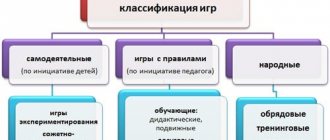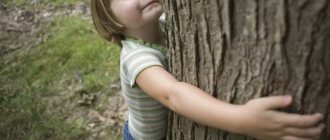Non-traditional forms and methods of developing children's speech in preschool educational institutions
The Federal State Educational Standard for Preschool Education identifies the educational area “Speech Development” as the basis. Speech is the basis for the development of all other types of children's activities: communication, cognition, cognitive research. In this regard, the development of speech of a young child becomes of particular relevance in the activities of a preschool teacher.
According to statistics, only about 15% of newborns are born completely healthy. The remaining children have various micro-organic damage or severe pathology. Speech is one of the mental functions that fundamentally distinguishes humans from other representatives of the animal world. Human speech is distinguished by communicative ability, i.e., a historically established form of communication between people using sound and visual signs, due to which it became possible to transmit information not only directly from person to person, but also over gigantic distances, as well as receive from the past and transmit to future. Speech is directly related to conscious forms of mental and voluntary activity. Forming in a child as he masters language, speech goes through several stages of development, turning into an expanded system of means of communication and mediation of various mental processes. A child’s speech is formed from the first days under the influence of the speech of adults and largely depends on sufficient speech practice, a normal speech environment, and on upbringing and training.
The number of children with various speech disorders has increased. Without delving into the causes and problems, it should be noted that speech disorders to varying degrees affect the formation of children’s personality and affect physical and mental development. It is well known that speech disorders in preschool children are not exclusively a speech therapy problem. These disorders limit children's cognitive abilities. Simultaneously with the speech sphere, the emotional and sensory-perceptual sphere of the child suffers. These children have extremely low performance. As practice shows, using conventional methods and techniques when working with such children does not always give an effective result. It is necessary to use new technologies that simultaneously ensure the cognitive development of children and stimulate their speech activity.
As an example, in our preschool institution, music classes are conducted jointly by the music director and the teacher. They learn songs, movements to music without words (rhythmoplasty), movements to music with words (logo rhythmics), as well as finger gymnastics, which greatly contributes to the development of the child’s speech.
The integrated structure of educational activities, firstly, gives children the opportunity to realize their creative potential, namely: to compose, fantasize, think, learn, and secondly, in an intensive playful form, children’s vocabulary is enriched, the grammatical structure of their speech is formed, and most importantly cognitive activity develops. Children transfer their emotional impressions and experience of perceiving music to speech activity: voice, creation of an expressive artistic speech image. The culture of auditory perception through the means of hearing allows a child to become a full-fledged spectator - a listener of fairy tales, dramatizations, and dramatizations available to him. The child shares his impressions from listening to musical works with peers and adults, thereby developing the communicative function of speech. The melody that accompanies the poems consists of simple, repeating phrases that can be played by preschool children. The rhythm and melody of rhyming focus attention on the morphological feature that needs to be consolidated in the child’s active or passive speech. Repeated perception and reproduction of grammatical forms, prepositional-case constructions, word combinations, with which rhyme is maximally saturated in accordance with the combination of the correction task and with the activation of various analyzers, contribute to the formation of morphological and syntactic generalizations in children in a shorter time. The criterion for carefully selecting the content of a rhyme is its correspondence to childhood experience. The simple text and melody of the rhyme are designed so that a child can sing along with an adult. Singing, or rather, drawing out vowels in a word, contributes to the development of speech breathing, a sense of rhythm, speech-auditory attention, memory, and the formation of an air stream. Poetic material with musical accompaniment has a beneficial effect on the emotional state of the child: it arouses keen interest and positive experiences, does not tire when repeated many times, forms motivation for classes, reduces emotional stress, and promotes an increase in overall activity.
The inclusion of musical and speech therapy means of language contributes not only to the solution of correctional problems, but also makes it possible to create favorable conditions for the emotional interaction of an adult and a child, which is especially important both during the period of adaptation to a preschool institution and at subsequent stages of work.
In classical preschool pedagogy, the idea of combining learning with play belongs to the German teacher F. Froebel. The theory of play learning was developed in the works of many foreign and domestic scientists - M. Montessori, A. P. Usov, V. N. Avanesov, E. N. Vodovozov and others. The influence of vocabulary work on coherent speech is described in detail by E. M. Strunina and O. S. Ushakova. Domestic pedagogy has accumulated sufficient theoretical, practical and methodological material on the study and development of the lexical and grammatical aspects of speech in preschoolers. Existing programs for teaching and raising children describe in detail the content and structure of frontal classes on the development of the lexical and grammatical aspects of speech. Numerous studies have shown the importance of games as a form of learning that promotes the assimilation, consolidation and systematization of knowledge, and the possibilities of using it in the speech development of preschool children.
Fairytale therapy, being an eclectic direction of practical psychology, gives the specialist greater freedom for creativity, allows harmonious integration and application of techniques from other areas of psychology. The use of fairy tales in preschool age contributes to the targeted development of the speech sphere. In a fascinating form and in words that are easy to understand, the fairy tale shows the child the life around him, people, their actions and destinies. Gives you a feel for what the hero’s actions will lead to. This is a unique opportunity to experience and play out life situations without harming one’s own life and destiny; it puts the fairy tale on par with the most effective methods of educational work with children. One of the most interesting syntheses of fairy tale therapy is fairy tale sand therapy. The method of fairy tale sand therapy, as one of the options for fairy tale therapy, allows you to effectively solve the problems of both psychological development of the individual and the correction of individual behavioral reactions.
In Russian folklore there are many fairy tales that are interesting and indicative for the understanding of children: “The Ryaba Hen”, “Turnip”, “Kolobok”, “Teremok”. Our kindergarten teachers, together with the music director, carefully develop the script for fairy tales, performances, entertainment, and theatrical games, taking into account the age characteristics and level of development of children. In these classes, children are not only spectators, but also active participants in what is happening, which causes them joy, an emotional response, and maintains interest throughout the entire game plot. Thus, the purpose of the lesson “The Adventure of Kolobok”, as a theatrical entertainment using non-traditional drawing techniques, is to consolidate knowledge of the Russian folk tale “Kolobok”, update knowledge about wild animals, learn to use non-traditional means of drawing, stimulate speech activity, train in pronouncing onomatopoeia, develop auditory attention, speech breathing, voice strength, articulation and fine motor skills, cultivate interest in folk art, productive activities, caring attitude towards animals, as well as activity, initiative, promote the development of positive emotions.
The following can be easily and organically included in a fairy tale dramatization and theatrical play:
− tasks for the development of general motor skills (for example, children, traveling through the forest, walk along a narrow bridge, jump from hummock to hummock, help their grandmother knead dough, take part in the construction of a new house for animals);
− voice and breathing exercises, tasks for the development of the articulatory apparatus (kids chase away a sly fox with a loud bark; blow on Kolobok, cooling it; when lost in the forest, they call for help: “Ay! Ay! Ay!”);
− games and tasks to develop attention and thinking (children guess riddles, remember fairy tale characters).
In addition, we use modern techniques in our work: children draw with their fingers, palms, using bulk materials, dry leaves; sand therapy (help the fox find lost beads in the sandbox); music therapy (pupils listen to the songs of the heroes and sing along with them); elements of psycho-gymnastics (depict a frightened bunny, a clumsy bear, a brave cockerel).
N.A. Sakovich believes that the client places miniature objects in a tray with wet or dry sand and creates pictures. Through contact with sand and miniatures, he puts into physical form his deepest conscious and unconscious thoughts and feelings. Sand therapy, which relies on active imagination and creative symbolic play, is a practical, experience-based method that can build a bridge between the unconscious and conscious, rational and emotional, spiritual and physical, non-verbal and verbal.
Traveling through fairy tales awakens imagination and imaginative thinking, frees you from stereotypes and templates, and gives scope for creativity.
The method of working with fairy tales has a centuries-old history. Today this method is one of the most widely covered in modern literature and one of the most promising. The advantage and role of this method in working with children with general speech underdevelopment today are undeniable: it is the figurativeness of the language, its metaphorical nature, and psychological security. While working on a fairy tale, children enrich their vocabulary, work is underway to automate the sounds and introduce them into independent speech. The texts of fairy tales expand vocabulary, help to organize dialogue correctly, and, therefore, influence the development of coherent monologue speech. Working with a fairy tale contributes to the development of the prosodic side of speech: voice timbre, its strength, tempo, intonation, expressiveness.
Literature:
- Alekseeva M. M., Yashina V. I. Reader on the theory and methods of speech development in preschool children: A textbook for students of higher and secondary pedagogical education. textbook establishments. - M.: Publishing House, 1999.
- Galiguzova L.N., Smirnova E.O. Stages of communication from one to seven years. - M.: Education, 1992.
- Kukushin V. S. Pedagogy of primary education / V. S. Kukushin, A. V. Boldyreva-Varaksina. - Rostov n/d.: Phoenix, 2005. - 592 p.
- Ushakova O. S., Strunina E. M. Methods of speech development for preschool children; Vlados - Moscow, 2010. - 288 p.
- Ushakova O. S., Strunina E. M. Speech development in children aged 5–6 years. Didactic materials; Ventana-Graf - Moscow, 2010. - 171 p.
- Chulkova A.V. Formation of dialogue in a preschooler; Phoenix - Moscow, 2008. - 224 p.
- Shalaeva Galina. Certificate with mom. Slovo, AST - Moscow, 2009. - 176 p.
- Yanushko E. A. Speech development in young children. 1–3 years; Mosaic-Synthesis - Moscow, 2010. - 628 p.
- Yashina V.I. Theory and methods of development of children’s speech / V.I. Yashina. - M.: Education, 2007. - 192 p.
Speech development of preschoolers through non-traditional technologies
Kotova Olga Olegovna teacher MBDOU d/s No. 27 Belgorod
It is obvious that children's speech is now becoming poorer. The use of synonyms, homonyms and other parts of speech during verbal and mental activity is sometimes not in demand in the children's vocabulary. The number of children with problems with speech development and sound pronunciation has increased. All this happens due to children’s dependence on TV, computers, and lack of communication with parents. Consequently, the process of developing coherent speech is the main task of speech education of children.
Thanks to speech, people understand each other, participate in joint activities, and learn about the world. Speech helps shape attitudes and beliefs. But a very short period is allotted for speech development: early and preschool age.
Working with children, I analyzed their communication in free activity, speech during various organized activities and heard the imperfection of speech statements, saw certain speech problems: children’s speech consists of simple sentences, poor in content, monosyllabic. In dialogical speech, many children are not able to correctly and clearly pose a question or give a short or detailed answer.
Most children do not know how to consistently construct a monologue: retell a text in their own words, compose a story on a topic, or describe a picture.
I concluded that children need to be taught grammatically correct speech and expand their vocabulary. In my work on speech development, along with traditional ones, I began to use non-traditional technologies and methods.
Advertising message
Using syncwine technologies and mnemonic techniques in working with children on the development of coherent speech, I noted a certain pattern in the interaction of these two technologies. Children’s mastery of creating unrhymed syncwine poems helps enrich and update the vocabulary, clarifies the content of concepts about the subject, and is also a diagnostic tool that allows the teacher to assess the child’s level of mastery of the material covered. Thus, the accumulated vocabulary contributes to the creative composition of text using mnemonic tables and easily replaces abstract objects with images. Consequently, these technologies contribute to the effective development of coherent speech. Using the integrated use of syncwine and mnemonics technologies in my work with children, I set the following tasks in my work on the development of coherent speech:
1. Introducing new words into a child’s speech in order to develop and enrich their vocabulary.
2.Formation of dialogical and monologue speech of children through innovative technologies syncwine and mnemonics.
3. Develop algorithms for mnemonic tables and poetic syncwine for use in educational and free activities with children on the development of speech in preschoolers.
These non-traditional technologies are interesting to children due to the presence of gaming techniques in them, are based on the use of children's creativity, and require independence in modeling circuits, compiling tables, etc.
It is believed that mnemonics facilitates memorization, increases memory capacity, as it allows one to anticipate and form additional associations, and conduct the learning process in a playful way. The use of mnemonics is currently becoming relevant. The main reason is that the child, using tables, mnemonic tracks, etc. in his imagination he connects several visual images that are interconnected. And children remember visual images easier and faster. And when it is necessary to remember the required material from one of the images, the brain reproduces all previously connected images. We know that the main content of a preschooler’s memory consists of representations of specific images of people, natural phenomena, events, objects, their properties, qualities, signs, and actions. Representations are the basis for storytelling, drawing, and games. And since preschool age is the age of figurative forms, it is therefore important that at this age children master figurative means: sensory standards, various symbols and signs (various kinds of visual models, diagrams, tables).
These techniques are preceded by work on creating an unrhymed poem - a syncwine.
Cinquain is translated from French as “five lines” - a five-line line of unrhymed poetry.
Scheme for compiling a syncwine:
- The first line is one word, usually a noun, reflecting the main idea (answers the question who? or what?)
- Second line – two words, adjectives, describing the noun
- (answers the question which one?, which one?, which one?, which ones?)
- The third line is three words, verbs that describe actions within the topic,
- (answers the question what did you do?, what did you do?).
- The fourth line is a sentence (phrase) of several words, showing the attitude to the topic, with the help of which you can express the meaning of the syncwine.
- The fifth line is the final word, associated with the first, reflecting the essence of the theme, which characterizes the entire syncwine.
Using syncwine, my children expanded and consolidated their vocabulary. Many children learned visual and graphic modeling of linguistic units. In the preparatory group, it became easy for me to teach children syllable-by-syllable reading and typing of letters, and to construct grammatically correct sentences.
After the children had formed a concept about a word, an object, its characteristics and actions, I began to actively introduce a new word into the compilation of mnemonic tracks, mnemonic squares, mnemonic tables, and to designate a word or sentence with a symbol that would be understood by the child.
A combination of mnemonics and syncwine techniques effectively solves cognitive, speech, educational, creative problems, the ability of children to briefly and accurately express their thoughts, and helps to better prepare children for school.
Currently, there are many methods and techniques that can be used when using mnemonic technologies and syncwine when teaching coherent speech to preschoolers:
- Trial and error method. Having understood the task, the child one by one puts forward ideas, evaluates them, and if he does not like them or does not suit him, discards them and puts forward new ones.
- Synectics method. The possibilities of the method are to make the unfamiliar familiar, and the familiar - alien. This work is based on the following technique: Empathy - personal similarity - the child’s ability to identify himself with someone or something, to be able to empathize with an object.
- Morphological analysis. The purpose of the method is to identify all possible solutions to a given problem that could be missed with a simple search.
- Method of focal objects. The method allows you to find ideas for new original ways and use them to consciously improve old ones and create new words or symbols when working with a table. To do this, we select an item that we want to improve or give other ordinary and unusual properties.
- Method of control questions. The test question method is a specialized form of questionnaires.
- System operator. The method helps to highlight parts of an object and see it in the present, past and future.
- Directory method. His goal is to compose a fairy tale from words chosen at random.
Other methods and techniques are also advisable for the development of coherent speech in preschoolers.
Thus, while studying the problem of speech development, I came to the conclusion that we cannot stop there, but on the contrary, we need to continue to study this problem in more depth and introduce new technologies. Thanks to the system in work, it is possible to develop the mental abilities of children, which is extremely important for further successful learning at school. I am already working on developing skills in joint learning activities and will continue this in the future. My goal is to ensure that every child, moving from kindergarten to school, has correct coherent speech, is able to construct common sentences, and has storytelling skills.
Material from the printed collection “ Kindergarten - the territory of the Federal State Educational Standard: modern methods and technologies of preschool education, autumn 2017.”
The use of non-traditional technologies in the speech development of preschool children
Svetlana Molokanova
The use of non-traditional technologies in the speech development of preschool children
The use of non-traditional technologies in the speech development of preschool children.
Formation of speech in preschoolers is an important and difficult task. The successful solution of this problem is necessary both for preparing children for the upcoming school education, and for comfortable communication with others. It has been proven that the more active a child is, the more he is involved in activities that interest him, the better the result. Therefore, it is necessary to change the way we work to develop the speech of preschoolers . To form and activate children's , along with traditional methods and techniques, I use non-traditional technologies . The purpose of my experience: the development of speech in preschool children through non-traditional and developmental technologies . Traditional methods of working on the development of children's speech are the basis , the foundation without which one cannot do. They are divided into three main groups: visual methods, verbal and practical. Of course, I use all these methods in my work .
Non-traditional methods are designed to maximize the effectiveness of work on the speech development of children . It is worth noting that this work is aimed at interaction not only with children, but also interaction with parents, and cooperation with institutions of the social and pedagogical environment. development through fine motor skills. The hand has the largest “representation”
in the cerebral cortex, therefore
the development of the hand plays an important role in the formation of the brain and the formation of speech.
There are many effective ways to develop fine motor skills that I used in my work . I would like to dwell on a non-standard technology : bioenergoplastics. Bioenergoplasty is the joint interaction of the hand and tongue. Interested in the topic “bioenergoplastics”
, I made several tutorials that
I used to automate the delivered sounds. also used bioenergoplasty techniques in articulatory gymnastics. Joint movements of the hands and tongue allow you to perform articulation exercises more clearly and accurately. Moreover, the options for showing exercises may be different. The mnemonics seemed interesting .
Mnemonics is a system of methods and techniques that ensure children’s successful acquisition of knowledge about the world around them, effective memorization, preservation and reproduction of information, and of course the development of speech . Mnemonic squares, tables, paths - were used when working on the development of coherent speech in children , to enrich vocabulary, when teaching how to compose stories, when retelling fiction, when guessing and making riddles, when memorizing poetry. The models were compiled both jointly by the children and the teacher, and by the children themselves.
For myself, I noted that one of the effective and interesting methods for enhancing cognitive activity and developing monologue speech in preschoolers is to work on creating a non-rhyming poem, a syncwine. Today it is very important to teach children not only to speak correctly and clearly, but also to think. The innovation of this method is the creation of conditions for the development of a personality capable of thinking critically, that is, eliminating the unnecessary and highlighting the main thing, generalizing, classifying. Already at preschool age, you can teach children to compose syncwines in the form of a game. Children independently and together with their parents compiled didactic syncwines on various lexical topics, thus creating a “piggy bank of syncwines”
which was successfully
used in the classroom .
When using theatrical activities, children's speech becomes figurative and expressive. In the process of working on the expressiveness of characters’ remarks and their own statements, the child’s vocabulary is imperceptibly activated, the sound culture of speech and its intonation structure are improved. the Teremok theater group successfully exists and creates in our kindergarten.
, whose productions delight
children and adults .
Using (TRIZ) in teaching activities
helps
to develop inventiveness , ingenuity, creative imagination, and dialectical thinking in preschoolers. The main means of working with children is pedagogical search. The teacher should not give the child ready-made knowledge; it is necessary to teach him to find it on his own. Using TRIZ technology , children resolved contradictions, using the brainstorming method, found a way out of hopeless situations, came up with the beginning and end of a story, composed stories on behalf of some living or inanimate object, came up with fairy tales and stories on various lexical topics, and composed fable stories , learned to come up with riddles.
Project activities have enormous developmental potential ; they not only create conditions for supporting and developing children’s interests and abilities, but are also aimed at developing the child’s individuality, independence, initiative, and search activity. The project method compensates for the problem of communication deficits and is an effective means of speech development for preschoolers . A large number of projects have been implemented in our kindergarten: “Creativity of Children's Writers”, “My Family”, “Young Kotovchanin”, “My Traffic Light”, etc. Fiction has a huge impact on the development of children's speech , contributes to the replenishment of vocabulary, thereby forming the communicative culture of preschoolers . At the same time, one of the main factors stimulating a child’s interest in reading is a reading family and the corresponding home book environment. In our kindergarten we decided to use this form of work with families of preschoolers as a “literary living room”.
The literary living room is an ideal form of organizing joint activities of preschoolers , parents and teachers.
We tried to revive this form of work, to focus on the interests of preschoolers and parents . And they decided to start with poetry. Literary sitting rooms were held dedicated to the work of S. Yesenin, where children heard not only magnificent poems, but also romances written based on the poet’s poems. The living room, dedicated to the work of A.S. Pushkin, pleased the children with a meeting with the heroes of the great poet’s fairy tales.
This form of organizing educational activities as a “literary living room” made it possible not only to introduce preschoolers to great poets , but also to create conditions conducive to the development of their creative abilities and emotional response to the content of poetic works.
The subject-development environment is of great importance for the development of young children who have not yet read , especially in their independent activities.
Therefore, we try to enrich the environment with possible means to ensure a variety of activities for children
In conclusion, I would like to note that a variety of work with children using various innovative and developmental technologies , the use of various forms of work with parents, contributed to the positive dynamics of speech development in preschoolers .
Bibliography:
1. Akimenko V. M. New pedagogical technologies : Textbook. -method. allowance. Rostov n/d., 2008.
2. Bolshova T.V. Learning from a fairy tale. Development of thinking in preschoolers using mnemonics. St. Petersburg ,200
3. Dushka N. “Sinkwine in working with preschoolers ”
, Journal
"Speech therapist"
No. 5
(2005)
.
4. Maletina N. S., Ponomareva L. V. Modeling in descriptive speech of children with ODD . Preschool education . 2004.№6. pp. 64-68.







